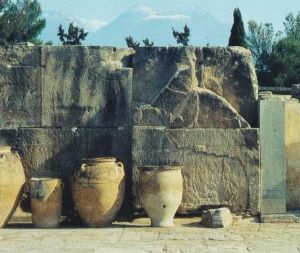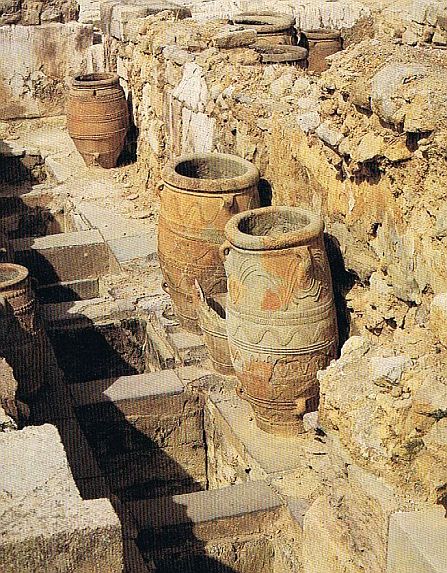[row]
[col span=”1/1″]
High-quality, custom made terracotta vessels from befriended Cretan workshops. Produced using century old traditional craftsmanship – they were daily use ceramics yesterday turned into frost-resistant terracotta ceramics for planting and decoration.
[/col]
[/row]
[row]
[col span=”1/2″]
The beginnings of the Cretan craftsmanship lies in the antiques and continued throughout centuries until today.
The vessels and terracotta amphora from those days are at display in all important museums of the western world. Not only the legendary 4000 year old storage vessel discoveries in the palace of Knossos have a striking resemblance with the pottery produced today.

For many centuries irreplaceable, they served as a refrigerator and storage container for the storage of almost all essential foods such as oil, water, wine, cereals. They were also used for transport and not only as transport container via roads but – as numerous underwater finds show – shiploads of goods were loaded stacked and transported on sea vessels using lying pointed amphorae.
When working with textiles and fabrics began to demand ceramic utilities the form of the so-called dyers pot was developed. The design and appearance of ceramic initially always stood in relation to the functionality of the utility needed. The idea of using ceramics for decorating is modern. The use of vessels for planting arose in connection with the popularity of orangeries in 17./18. century. Neither has played much of a role in the old Greece. With the upcoming of newer materials, especially the plastics alongside more modern industrial production techniques, the ceramic storage vessels came out of fashion and the potter families struggled to sustain their livelihood.
It is thanks to the support of UNESCO that the international cultural heritage is being kept alive in Crete as the only place in Europe,allowing family workshops and cooperatives do continue producing not only, but especially amphorae, large pottery and terracotta planter pottery. The fact that the vessels have proven to be frost resistant in Central and Northern European climates has additionally helped secure the continuation of their production.
Terrakotta (ital. ‘Terra cotta’), initially translated merely “burnt earth” and has become synonymous to us as a general term for un-glazed ceramic products and garden ceramics and stands for the warm, earthy reddish hue which is so typical for this ceramic.
[/col]
[col span=”1/2″]
In the traditional combination of building and turning the clay each vessel is being build by hand on a special potters wheel. Today’s difference being that the wheel is not exclusively turned by hand but partially by electricity.
In the contrary to this technique the terracotta pottery and decoration elements of this size being produced in Asia or e.g. the so called Impruneta Ceramic from Italy is largely build using moulds and forms.

The shaping of the vessel, easily recognized by the parallel running finger creasing on the inside of the wall leads to a thinness of the vessel which makes it significantly lighter that the moulded equivalent. This makes the handling of the pottery a lot easier. (Every now and then the opinion is circulated that the thicker the wall of a vessel the more frost resistant is wrong as the two issues are completely untelated). the clay used is locally sourced and not technically tempered with leading to a rough, sometimes broken surface with inclusions of chalk or stone splinters which is the basis for the varying yellow and red shades of the product.
Those will finally be preserved in the burning process for which large chamber ovens are used, partially traditionally heated by timber but more and more often using environmentally more apporpriate natural gasoline. Temperatures of up to 1100 degrees Celsius are sealing the porous clay so tightly that water filled vessels can be considered water tight and usually only “imbue” but not leak.
In any case the terracotta planters have proven to be completely frost resistant, hecne can spend the entire year in the outdoors with or without plants.
[/col]
[/row]
[row ]
[col span=”1/1″ ]
[title text=”Production techniques today”]
Pictures from our workshop visit to Crete
Compared to pictures from the late 1950′ or early 1960′ you can see how unchanged the traditional shapes as well as the construction techniques have remained.
The use of electricity made a difference away from sweaty, hard work and physically very unhealthy techniques of manually turning the table.
[/col]
[/row]
[ux_slider]
[ux_banner bg=”https://www.kreta-keramik.com/wp-content/uploads/2016/01/1.jpg” height=”640px” text_color=”light” text_align=”left” text_pos=”center” text_width=”80%” animation=”flipInX”]
[/ux_banner]
[ux_banner bg=”https://www.kreta-keramik.com/wp-content/uploads/2016/01/2.jpg” height=”640px” text_color=”light” text_align=”left” text_pos=”center” text_width=”80%” animation=”flipInX”]
[/ux_banner]
[ux_banner bg=”https://www.kreta-keramik.com/wp-content/uploads/2013/08/31.jpg” height=”640px” text_color=”light” text_align=”left” text_pos=”center” text_width=”80%” animation=”flipInX”]
[/ux_banner]
[ux_banner bg=”https://www.kreta-keramik.com/wp-content/uploads/2016/01/4.jpg” height=”640px” text_color=”light” text_align=”left” text_pos=”center” text_width=”80%” animation=”flipInX”]
[/ux_banner]
[ux_banner bg=”https://www.kreta-keramik.com/wp-content/uploads/2016/01/5.jpg” height=”640px” text_color=”light” text_align=”left” text_pos=”center” text_width=”80%” animation=”flipInX”]
[/ux_banner]
[ux_banner bg=”https://www.kreta-keramik.com/wp-content/uploads/2016/01/6.jpg” height=”640px” text_color=”light” text_align=”left” text_pos=”center” text_width=”80%” animation=”flipInX”]
[/ux_banner]
[ux_banner bg=”https://www.kreta-keramik.com/wp-content/uploads/2016/01/7.jpg” height=”640px” text_color=”light” text_align=”left” text_pos=”center” text_width=”80%” animation=”flipInX”]
[/ux_banner]
[ux_banner bg=”https://www.kreta-keramik.com/wp-content/uploads/2016/01/8.jpg” height=”640px” text_color=”light” text_align=”left” text_pos=”center” text_width=”80%” animation=”flipInX”]
[/ux_banner]
[ux_banner bg=”https://www.kreta-keramik.com/wp-content/uploads/2016/01/9.jpg” height=”640px” text_color=”light” text_align=”left” text_pos=”center” text_width=”80%” animation=”flipInX”]
[/ux_banner]
[ux_banner bg=”https://www.kreta-keramik.com/wp-content/uploads/2016/01/10.jpg” height=”640px” text_color=”light” text_align=”left” text_pos=”center” text_width=”80%” animation=”flipInX”]
[/ux_banner]
[/ux_slider]
[row ]
[col span=”1/1″ ]
[title text=”Production techniques before”]
Historical pictures of the production techniques
These pictures pre-date the use of electric power in traditional pottery in the late 1950′ and early 1960′.
They do allow a peek into historical workshops as the documented working conditions do show the exact procedured and working conditions which have been used and not much amended for centuries.
Origin: „R. Hampe / A. Winter / Bei Töpfern und Töpferinnen in Kreta, Messenien und Zypern. 1962. Verlag des Römisch-Germanischen Zentralmuseums Mainz“ (18) und „B. Psaropulu / N. Simantirakis, Thrapsano: Chorio ton Aggioplaston. Athen 2007.“ (9)
[/col]
[/row]
[ux_slider]
[ux_banner bg=”https://www.kreta-keramik.com/wp-content/uploads/2013/08/tafel-1.jpg” height=”640px” text_color=”light” text_align=”left” text_pos=”center” text_width=”80%” animation=”flipInX”]
[/ux_banner]
[ux_banner bg=”https://www.kreta-keramik.com/wp-content/uploads/2013/08/tafel-1-6.jpg” height=”640px” text_color=”light” text_align=”left” text_pos=”center” text_width=”80%” animation=”flipInX”]
[/ux_banner]
[ux_banner bg=”https://www.kreta-keramik.com/wp-content/uploads/2013/08/tafel-2-1.jpg” height=”640px” text_color=”light” text_align=”left” text_pos=”center” text_width=”80%” animation=”flipInX”]
[/ux_banner]
[ux_banner bg=”https://www.kreta-keramik.com/wp-content/uploads/2013/08/tafel-2-3.jpg” height=”640px” text_color=”light” text_align=”left” text_pos=”center” text_width=”80%” animation=”flipInX”]
[/ux_banner]
[ux_banner bg=”https://www.kreta-keramik.com/wp-content/uploads/2013/08/tafel-2-5.jpg” height=”640px” text_color=”light” text_align=”left” text_pos=”center” text_width=”80%” animation=”flipInX”]
[/ux_banner]
[ux_banner bg=”https://www.kreta-keramik.com/wp-content/uploads/2013/08/tafel-4-1.jpg” height=”640px” text_color=”light” text_align=”left” text_pos=”center” text_width=”80%” animation=”flipInX”]
[/ux_banner]
[ux_banner bg=”https://www.kreta-keramik.com/wp-content/uploads/2013/08/tafel-4-5.jpg” height=”640px” text_color=”light” text_align=”left” text_pos=”center” text_width=”80%” animation=”flipInX”]
[/ux_banner]
[ux_banner bg=”https://www.kreta-keramik.com/wp-content/uploads/2013/08/tafel-5-5.jpg” height=”640px” text_color=”light” text_align=”left” text_pos=”center” text_width=”80%” animation=”flipInX”]
[/ux_banner]
[ux_banner bg=”https://www.kreta-keramik.com/wp-content/uploads/2013/08/tafel-7-1.jpg” height=”640px” text_color=”light” text_align=”left” text_pos=”center” text_width=”80%” animation=”flipInX”]
[/ux_banner]
[ux_banner bg=”https://www.kreta-keramik.com/wp-content/uploads/2013/08/tafel-4-3.jpg” height=”640px” text_color=”light” text_align=”left” text_pos=”center” text_width=”80%” animation=”flipInX”]
[/ux_banner]
[ux_banner bg=”https://www.kreta-keramik.com/wp-content/uploads/2013/08/tafel-6-4.jpg” height=”640px” text_color=”light” text_align=”left” text_pos=”center” text_width=”80%” animation=”flipInX”]
[/ux_banner]
[ux_banner bg=”https://www.kreta-keramik.com/wp-content/uploads/2013/08/tafel-8-4.jpg” height=”640px” text_color=”light” text_align=”left” text_pos=”center” text_width=”80%” animation=”flipInX”]
[/ux_banner]
[ux_banner bg=”https://www.kreta-keramik.com/wp-content/uploads/2013/08/tafel-9-2.jpg” height=”640px” text_color=”light” text_align=”left” text_pos=”center” text_width=”80%” animation=”flipInX”]
[/ux_banner]
[ux_banner bg=”https://www.kreta-keramik.com/wp-content/uploads/2013/08/tafel-13-1.jpg” height=”640px” text_color=”light” text_align=”left” text_pos=”center” text_width=”80%” animation=”flipInX”]
[/ux_banner]
[ux_banner bg=”https://www.kreta-keramik.com/wp-content/uploads/2013/08/tafel-11-1.jpg” height=”640px” text_color=”light” text_align=”left” text_pos=”center” text_width=”80%” animation=”flipInX”]
[/ux_banner]
[ux_banner bg=”https://www.kreta-keramik.com/wp-content/uploads/2013/08/tafel-11-2.jpg” height=”640px” text_color=”light” text_align=”left” text_pos=”center” text_width=”80%” animation=”flipInX”]
[/ux_banner]
[ux_banner bg=”https://www.kreta-keramik.com/wp-content/uploads/2013/08/tafel-21.jpg” height=”640px” text_color=”light” text_align=”left” text_pos=”center” text_width=”80%” animation=”flipInX”]
[/ux_banner]
[/ux_slider]
Every piece a “one in a kind”.
Erk Kanis, Inhaber
 Frostfeste handgearbeitete Qualitätsterrakotta
Frostfeste handgearbeitete Qualitätsterrakotta